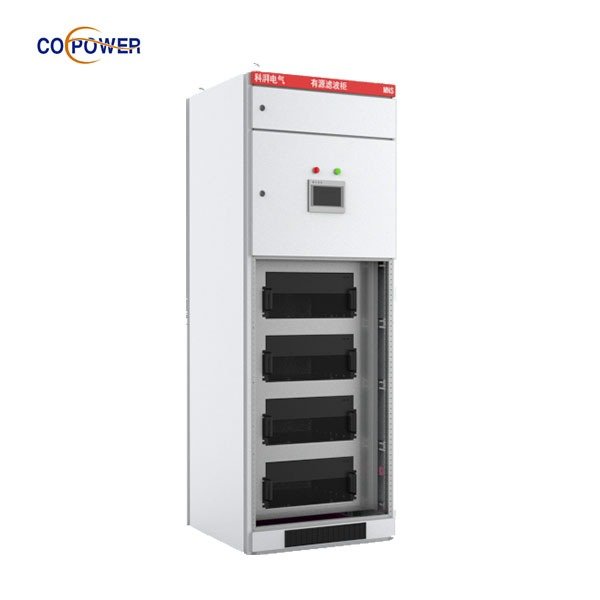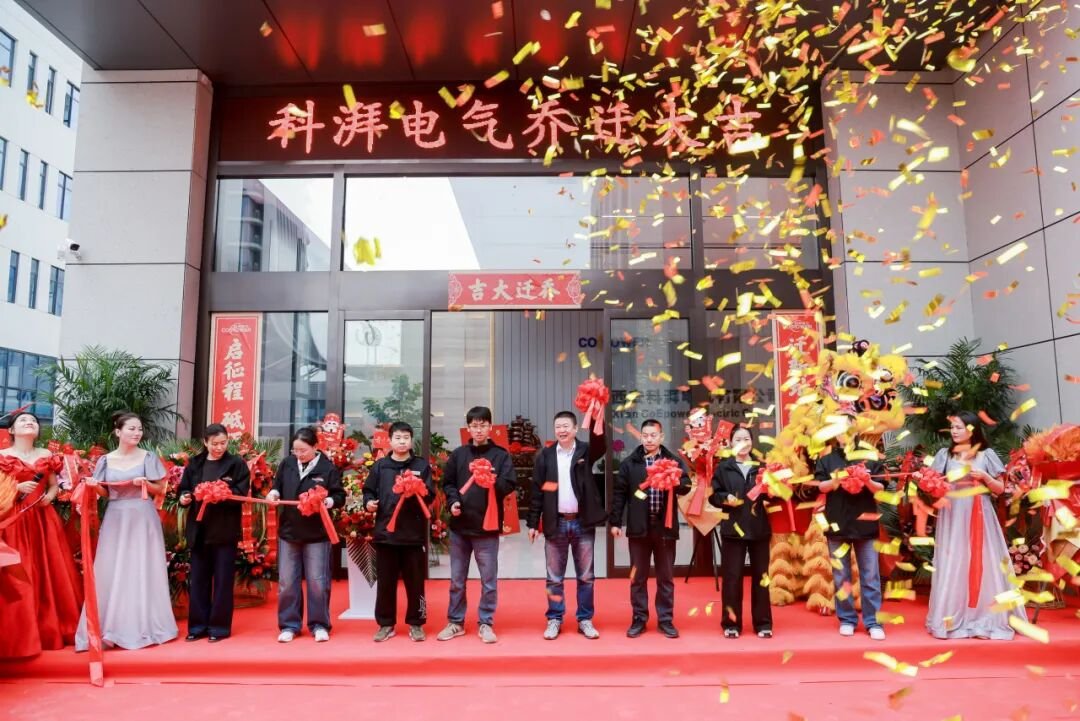در شبکه های برقی مدرن - به ویژه آنهایی که از تسهیلات صنعتی بهره می برند, مراکز داده, و ساختمانهای تجاری-اعوجاج هرمونیک ایجاد شده توسط بارهای غیرخطی (مثل VFDS, سیستم های UPS, و رانندگان را رهبری می کنند) چالش مهمی برای کیفیت برق ایجاد می کند. انتخاب استراتژی کاهش هارمونیک مناسب کلیدی است. این وبلاگ به فیلترهای هارمونیک فعال می پردازد (AHFS) در مقابل فیلترهای هارمونیک غیرفعال (PHF ها) و شما را راهنمایی می کند که چه زمانی باید هر کدام را انتخاب کنید—با ادغام بینش ها راه حل های فعال فیلتر هارمونیک Coepower.
فیلترهای هارمونیک غیرفعال (PHF ها)
PHF ها از اجزای سنتی - سلف ها استفاده می کنند, خازن, مقاومت - تنظیم شده برای هدف قرار دادن فرکانس های هارمونیک خاص. آنها ساده و مقرون به صرفه هستند, ایده آل برای قابل پیش بینی, سیستم های ایستا که در آن محتوای هارمونیک تغییر نمی کند. اما آنها:
-فقط در فرکانس های از پیش طراحی شده کار کنید
-می تواند از مشکلات رزونانس رنج ببرد
-ممکن است یک ضریب قدرت پیشرو در هنگام تخلیه معرفی کند
فیلترهای هارمونیک فعال (AHFS)

AHF ها نشان دهنده یک مدرن هستند, راه حل پویا. آنها به طور مداوم اختلالات هارمونیک را با استفاده از حسگرها و DSP نظارت می کنند, سپس جریان های جبران کننده را برای خنثی کردن آن هارمونیک ها در زمان واقعی تزریق کنید
مزایا عبارتند از:
-سازگاری بلادرنگ با تغییرات بار
-هدف قرار دادن طیف وسیعی از هارمونیک ها
-بدون ضریب قدرت پیشرو در بار کم
-نقاط نصب انعطاف پذیر (به عنوان مثال. در PCC یا تابلوهای برق)
چه زمانی یک فیلتر غیرفعال را انتخاب کنید
بهترین برای:
-مجرد, منابع هارمونیک پایدار - مانند یک VFD منفرد با فرکانس شناخته شده
-پروژه های با محدودیت بودجه - هزینه اولیه پایین تر; نگهداری کمتر
-برنامه های کاربردی با بارهای قابل پیش بینی - سیستم های SCADA, درایوهای موتور خاص, OTC.
معایب:
-نسبت به تغییرات بار سیستم انعطاف ناپذیر است
-خطر رزونانس و ناکارآمدی در شرایط مختلف
-به تنظیم در هر دستگاه نیاز دارد—اگر مقیاس بندی شود ممکن است هزینه بر باشد
زمان انتخاب فیلتر فعال
ایده آل برای:
-سیستم های پیچیده با چند, بارهای متغیر - مراکز داده, محیط های گیاهی چند VFD
-برنامه هایی که به THD بسیار کم نیاز دارند (به عنوان مثال. محدودیت های IEEE-519: <5-8٪)- AHF ها حتی در بار کم نیز موثر باقی می مانند
-تاسیسات متمرکز (نقطه مشترک در مقابل هر VFD) ارائه انعطاف پذیری نصب
-سیستم هایی که نیاز به جبران توان راکتیو یا بالانس سه فاز دارند
مبادلات:
-هزینه اولیه بالاتر
-به برنامه ریزی و پیکربندی ماهرانه نیاز دارد
-تعمیر و نگهداری کمی بالاتر به دلیل تجهیزات الکترونیکی - اما عملکرد طولانی مدت عالی را ارائه می دهد
فیلتر هارمونیک فعال CoEpower: مزایای فوکوس
ادغام بینش های APF CoEpower این تصمیم گیری را بالا می برد:
کاهش هارمونیک پویا: از الگوریتم های DSP با سرعت بالا برای نظارت و جبران جریان های هارمونیک در زمان واقعی استفاده می کند..
فرم فاکتورهای انعطاف پذیر: قفسه نصب شده را ارائه می دهد, دیواری, و گزینه های یکپارچه کابینه برای استقرار بدون درز.
پاسخ سریع & دقت بالا: ایده آل برای برنامه های کاربردی که در آن دقت و سرعت در اولویت هستند.
مقیاس پذیری: طراحی های مدولار گسترش آسان را با تکامل پروفیل های بار تسهیل می کند; مناسب برای عملیات رشد.
جدول مقایسه سریع
| معیارها | فیلترهای هارمونیک غیرفعال (PHF ها) | فیلترهای هارمونیک فعال (AHFS) - CoEpower |
|---|---|---|
| بهترین حالت استفاده | هارمونیک های تک منبع پایدار | متغیر, سیستم های چند باری |
| هزینه | CapEx کم, حداقل تعمیر و نگهداری | CapEx بالاتر, حداقل هزینه های بلند مدت |
| سازگاری | فقط تنظیم فرکانس ثابت | زمان واقعی, غرامت جامع |
| نصب | در هر منبع هارمونیک | قرار دادن متمرکز یا انعطاف پذیر |
| عمل | برای کنترل اولیه THD کافی است | برتر در محدوده بار, حتی تحت بار سبک |
| عامل قدرت | ممکن است منجر به PF شود | PF را حفظ می کند, گاهی اوقات آن را بهبود می بخشد |
| اندازه & مدولار بودن | حجیم, در هر دستگاه | فشرده, مدولار, مقیاس پذیر |
| ویژگی های CoEpower | - | مبتنی بر DSP, نصب چندگانه, پاسخ سریع |
پایان
-فیلترهای غیرفعال به سادگی می درخشند, آگاه به بودجه, و محیط های پایدار.
-فیلترهای فعال, به خصوص APF های CoEpower, اکسل جایی که بارها در نوسان هستند, دقت مهم است, و مقیاس پذیری آینده ضروری است.
برای کسب اطلاعات بیشتر، صفحه محصول فیلتر هارمونیک فعال ما را کاوش کنید:
با تراز کردن فیلتر مناسب با پیچیدگی سیستم شما, نیازهای عملکردی, و زیرساخت, کیفیت برق بهینه را تضمین می کنید, بهره وری, و قابلیت اطمینان.
برچسب ها: فیلترهای هارمونیک فعال در مقابل غیرفعال, زمان استفاده از فیلترهای هارمونیک فعال, مزایا و معایب فیلتر هارمونیک غیرفعال, فیلتر هارمونیک فعال Coepower, استراتژی های کاهش هماهنگ, سیستم الکتریکی کاهش THD, فناوری APF مبتنی بر DSP, فیلتر هارمونیک رک.


